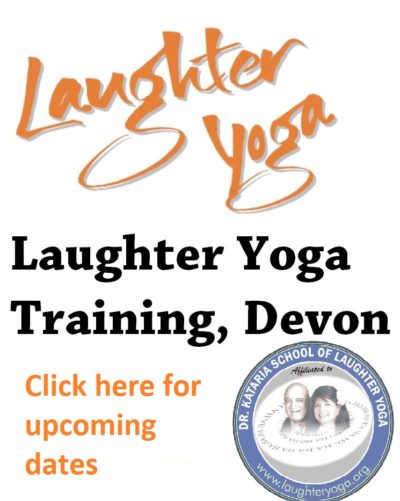Laughing Yoga or Laughter Yoga – what’s the difference?
I often hear people call Laughter Yoga, “Laughing Yoga”. In fact one man has just phoned me, keen to find out how to become qualified in “Laughing Yoga” in Devon. It was his phone call that prompted this post.
I asked him, “Do you want to become a Yoga expert that laughs, or would you like to learn Laughter Yoga?”. Of course we had a good laugh about it, and he’s decided he would definitely like to learn Laughter Yoga. However there is a serious point to this. Becoming a Yoga Teacher (in one of the more traditional forms of Yoga) takes many years. It’s a complex business, understanding both their own inner experience and helping to guide others. They are often working with people in a physical, physiological and emotional/spiritual/meditative way, and they are showing people how to bend into challenging shapes, Downward Dogs, Upward Suns and everything in between.
I consider these traditional Yoga teachers to be experts in their subject, and because they have undertaken such a rigorous training. I delight in hearing about different types of Yoga – for example, hot yoga, Kundalini Yoga. Or my most recent favourite – Aerial Yoga! WOW – these people are swinging from folds of fabric, held in harnesses, doing gravity-challenging stretches and moves. It’s gracious – and isn’t all Yoga gracious?

Photo by Kah Lok Leong on Unsplash
Laughter or Laughing Yoga holds many similarities with the traditional yoga’s in the world, but one thing it probably isn’t is gracious!
Here are some of the similarities and differences:
Name: should Laughing Yoga or Laughter Yoga even be called “Yoga”? Yoga – the word means “yoke” or join. With Laughter Yoga, the yoga creates the join between Laughter and deep Yogic breathing. It isn’t the serious sort of word that some people consider it to be.
Exercise: Laughter Yoga offers a series of movements, but these are much more relaxed than a traditional Yoga session. They may even include lying on the floor – however that is often accompanied with snorting, giggling and guffawing.
With Laughter Yoga, nobody will be telling anyone to “make a certain position”. The person doing Laughter Yoga has the choice to participate or not – and they are always advised not to push it. If they feel uncomfortable or any unusual pains, then the advice is ALWAYS to stop!
Meditation: Laughter Yoga sessions usually end with a Laughter Meditation – which is a way to allow yourself to laugh freely and with conscious awareness.
Guided meditation: Laughing Yoga sessions often also finish up with a Guided Meditation or a mindfulness moment, where people are gradually brought back into their own awareness. This session can be the most deep and delightful experienced (many people report that finding to me) because so much adrenalin and stress hormones have been dispersed, people find they can gain true inner peace.
Equipment: Laughter Yoga can be done with absolutely no equipment, not even a yoga mat. Often Laughing Yoga Leaders will run a Laughter Yoga session outdoors in a park, with nothing but their own sense of fun and joy.
So – as Laughing Yoga, or Laughter Yoga, includes movement, meditation, conscious use of laughter to make ourselves feel great and to connect with others around us. Perhaps the only difference between Laughter Yoga and traditional yoga is in the body stretches and the requirements of physiological training.
Perhaps it’s grace and silence that differentiate yoga from Laughing Yoga?
I was also going to suggest that the graceful movements and often silent tradition of traditional yoga might be another difference, but a friend has just phoned me. She’s just come home from her Kundalini Yoga class, and apparently tonight her lentil curry wasn’t fully digested before she attempted a complex stretch. The resultant breaking wind meant the whole class erupted in laughter. So it seems even traditional Yoga is not without its laughter… nor is it always totally refined and graceful, which is precisely when it becomes Laughing Yoga.




